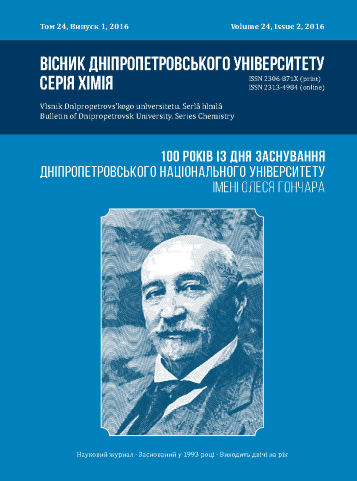Radical decomposition of 2,4-dinitrotoluene (DNT) at conditions of advanced oxidation. Computational study
DOI:
https://doi.org/10.15421/081608Keywords:
2, 4-dinitrotoluene, hydroxyl radical, Fenton oxidation, DFT, reaction mechanismAbstract
At the present time one of the main remediation technologies for such environmental pollutant as 2,4-dinitrotoluene (DNT) is advanced oxidation processes (AOPs). Since hydroxyl radical is the most common active species for AOPs, in particular for Fenton oxidation, the study modeled mechanism of interaction between DNT and hydroxyl radical at SMD(Pauling)/M06-2X/6-31+G(d,p) level. Computed results allow to suggest the most energetically favourable pathway for the process. DNT decomposition consists of sequential hydrogen abstractions and hydroxyl attachments passing through 2,4-dinitrobenzyl alcohol, 2,4-dinitrobenzaldehyde, and 2,4-dinitrobenzoic acid. Further replacement of nitro- and carboxyl groups by hydroxyl leads to 2,4-dihydroxybenzoic acid and 2,4-dinitrophenol, respectively. Reaction intermediates and products are experimentally confirmed. Mostly of reaction steps have low energy barriers, some steps are diffusion controlled. The whole process is highly exothermic.References
Oh, S.-Y., Seo, Y.-D., & Ryu, K.-S. (2016). Reductive removal of 2,4-dinitrotoluene and 2,4-dichlorophenol with zero-valent iron-included biochar. Bioresource Technol., 216, 1014–1021. doi:10.1016/j.biortech.2016.06.061 CrossRef
Jiang, S., Zhu, J., Ding, Y., Bai, S., Guan, Y., & Wang, J. (2016). Degradation Effect and Mechanism of Dinitrotoluene Wastewater by Magnetic Nano-Fe3O4/H2O2 Fenton-like. Ozone: Sci. Engin., 38(3), 225–232. doi:10.1080/01919512.2015.1115716 CrossRef
doi: Ho, P. C. (1986). Photooxidation of 2,4-dinitrotoluene in aqueous solution in the presence of hydrogen peroxide. Environ. Sci. Technol., 20(3), 260–267. doi:10.1021/es00145a007 CrossRef
Larson, R. A., Jafvert, C. T., Bosca, F., Marley, K. A., & Miller, P. L. (2000). Effects of surfactants on reduction and photolysis (>290 nm) of nitroaromatic compounds. Environ. Sci. & Technol., 34(3), 505–508. doi:10.1021/es990891e CrossRef
doi: He, Y., Zhao, B., Hughes, J. B., & Han, S. S. (2008). Fenton oxidation of 2,4- and 2,6-dinitrotoluene and acetone inhibition. Front. Environ. Sci. Engin. China, 2(3), 326–332. doi:10.1007/s11783-008-0038-4 CrossRef
Mohanty, N. R., & Wei, I. W. (1993). Oxidation of 2,4-Dinitrotoluene Using Fenton's Reagent: Reaction Mechanisms and Their Practical Applications. Hazard. Waste Hazard. Mater., 10(2), 171–183. doi:10.1089/hwm.1993.10.171 CrossRef
Olson, E. J., Isley III, W. C., Brennan, J. E., Cramer, C. J., & Buhlmann, P. (2015). Electrochemical Reduction of 2,4-Dinitrotoluene in Aprotic and pH-Buffered Media. J. Phys. Chem. C, 119 (23), 13088–13097. doi:10.1021/acs.jpcc.5b02840 CrossRef
Jho, E. H., Jung, J.-W., & Nam, K. (2013). Different fate of Pb and Cu at varied peroxide concentrations during the modified Fenton reaction in soil and its effect on the degradation of 2,4-dinitrotoluene. J. Chem. Technol. Biotechnol., 88(8), 1481–1487. doi:10.1002/jctb.3991 CrossRef
Sviatenko, L., Kinney, C., Gorb, L., Hill, F. C., Bednar, A. J., Okovytyy, S., & Leszczynski, J. (2014). Comprehensive Investigations of Kinetics of Alkaline Hydrolysis of TNT (2,4,6-Trinitrotoluene), DNT (2,4-Dinitrotoluene), and DNAN (2,4-Dinitroanisole). Environ. Sci. Technol., 48 (17), 10465–10474. doi:10.1021/es5026678 CrossRef
Oh, S.-Y., Yoon, H.-S., Jeong, T.-Y., & Kim, S. D. (2016). Evaluation of remediation processes for explosive-contaminated soils: kinetics and Microtox® bioassay. J. Chem. Technol. Biotechnol., 91, 928–937. doi:10.1002/jctb.4658 CrossRef
Mahbub, P., & Nesterenko, P. N. (2016). Application of photo degradation for remediation of cyclic nitramine and nitroaromatic explosives. RSC Adv., 6, 77603–77621. doi:10.1039/C6RA12565D CrossRef
Chen, W.-S., Jhou, Y.-C., & Huang, C.-P. (2014). Mineralization of dinitrotoluenes in industrial wastewater by electro-activated persulfate oxidation. Chem. Eng. J., 252, 166–172. doi:10.1016/j.cej.2014.05.033 CrossRef
Frisch, M. J., Trucks, G. W., Schlegel, H. B., Scuseria, G. E., Robb, M. A., Cheeseman, J. R., Scalmani, G., Barone, V., Mennucci, B., Petersson, G. A., Nakatsuji, H., Caricato, M., Li, X., Hratchian, H. P., Izmaylov, A. F., Bloino, J., Zheng, G., Sonnenberg, J. L., Hada, M., Ehara, M., Toyota, K., Fukuda, R., Hasegawa, J., Ishida, M., Nakajima, T., Honda, Y., Kitao, O., Nakai, H., Vreven, T., Montgomery, Jr., J. A., Peralta, J. E., Ogliaro, F., Bearpark, M., Heyd, J. J., Brothers, E., Kudin, K. N., Staroverov, V. N., Kobayashi, R., Normand, J., Raghavachari, K., Rendell, A., Burant, J. C., Iyengar, S. S., Tomasi, J., Cossi, M., Rega, N., Millam, J. M., Klene, M., Knox, J. E., Cross, J. B., Bakken, V., Adamo, C., Jaramillo, J., Gomperts, R., Stratmann, R. E., Yazyev, O., Austin, A. J., Cammi, R., Pomelli, C., Ochterski, J. W., Martin, R. L., Morokuma, K., Zakrzewski, V. G., Voth, G. A., Salvador, P., Dannenberg, J. J., Dapprich, S., Daniels, A. D., Farkas, Ö., Foresman, J. B., Ortiz, J. V., Cioslowski, J., & Fox, D. J. (2009). Gaussian 09 (Revision A.02) [Computer software]. Gaussian Inc., Wallingford CT.
Zhao, Y., & Truhlar, D. G. (2008). The M06 suite of density functionals for main group thermochemistry, thermochemical kinetics, noncovalent interactions, excited states, and transition elements: two new functionals and systematic testing of four M06-class functionals and 12 other functional. Theor. Chem. Account, 120, 215–241. doi:10.1007/s00214-007-0310-x CrossRef
Downloads
Published
Issue
Section
License
Copyright (c) 2016 Oles Honchar Dnipropetrovsk National University

This work is licensed under a Creative Commons Attribution 4.0 International License.
- Authors reserve the right of attribution for the submitted manuscript, while transferring to the Journal the right to publish the article under the Creative Commons Attribution License. This license allows free distribution of the published work under the condition of proper attribution of the original authors and the initial publication source (i.e. the Journal)
- Authors have the right to enter into separate agreements for additional non-exclusive distribution of the work in the form it was published in the Journal (such as publishing the article on the institutional website or as a part of a monograph), provided the original publication in this Journal is properly referenced
- The Journal allows and encourages online publication of the manuscripts (such as on personal web pages), even when such a manuscript is still under editorial consideration, since it allows for a productive scientific discussion and better citation dynamics (see The Effect of Open Access).


